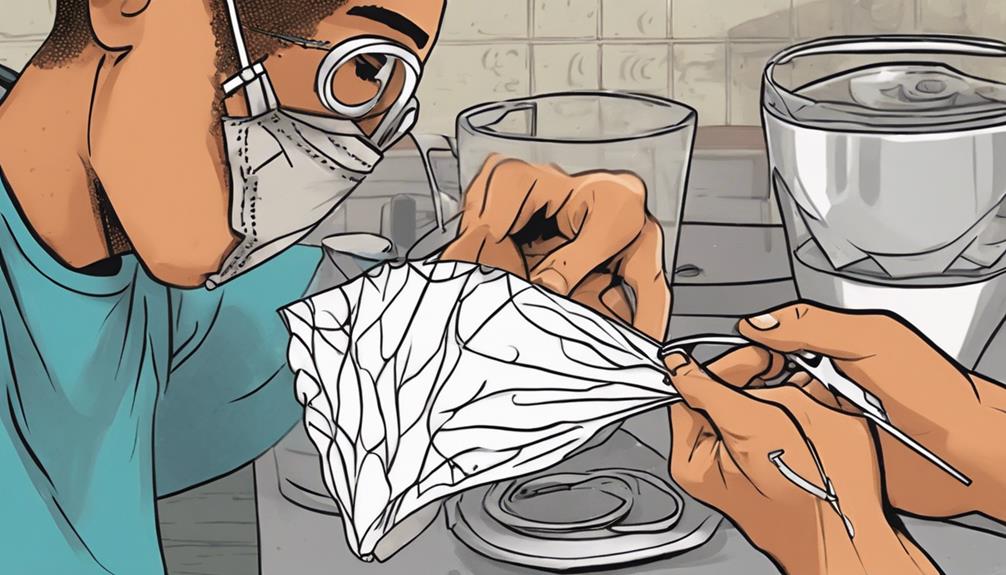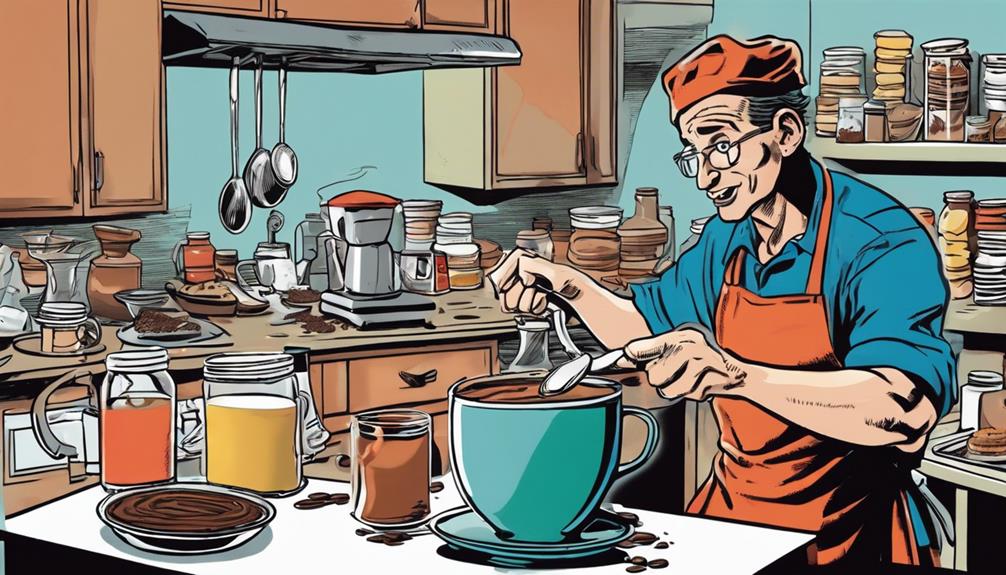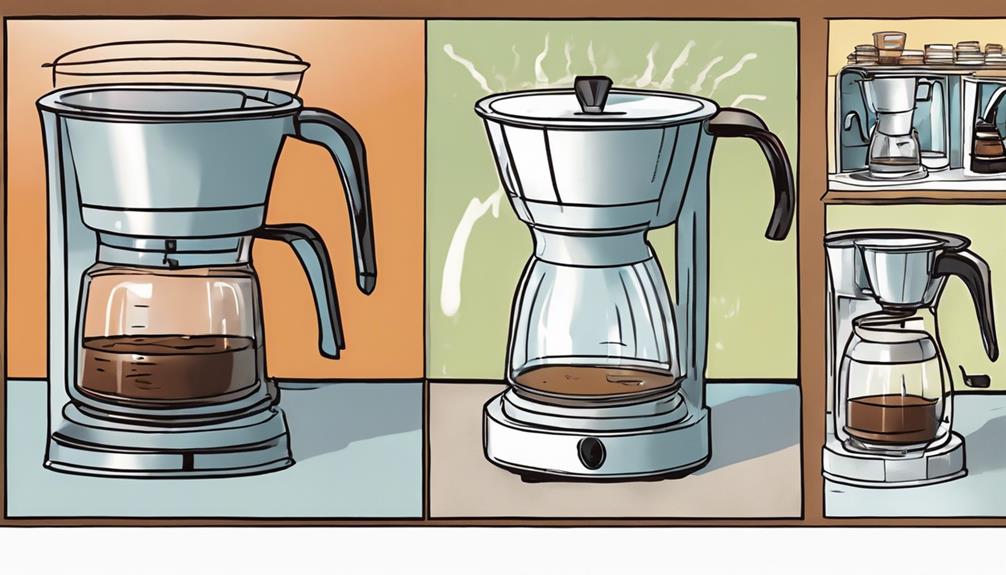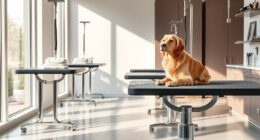Attach a coffee filter to your homemade face mask by folding it in half and inserting it into the pocket. Use tape to secure it for added protection. Ensure easy replacement by using rubber bands for ear loops and a paper tube to shape the mask. This technique improves filtration without causing discomfort. Let’s effortlessly enhance the effectiveness of your face mask!
Key Takeaways
- Select a face mask pattern with a filter pocket.
- Fold a thin coffee filter to fit the pocket.
- Secure the filter with tape for a snug fit.
- Ensure easy replacement of the coffee filter.
- Use rubber bands or elastics for ear loops.
Filter Materials Overview
Exploring the different materials used as filters in DIY face masks can help you understand the benefits of incorporating coffee filters for added protection. Coffee filters have gained popularity due to their ability to provide extra filtration when used as a filter layer in masks.
These filters are thin, making it easy to fold and insert them into masks for a snug fit. Research indicates that using multiple layers of coffee filters can significantly improve the effectiveness of masks by enhancing particle filtration.
When added as a filter layer, coffee filters can serve as an additional barrier against harmful particles. Their fine texture helps capture tiny particles, increasing the overall filtration capacity of the mask.
DIY Face Mask Pattern Options
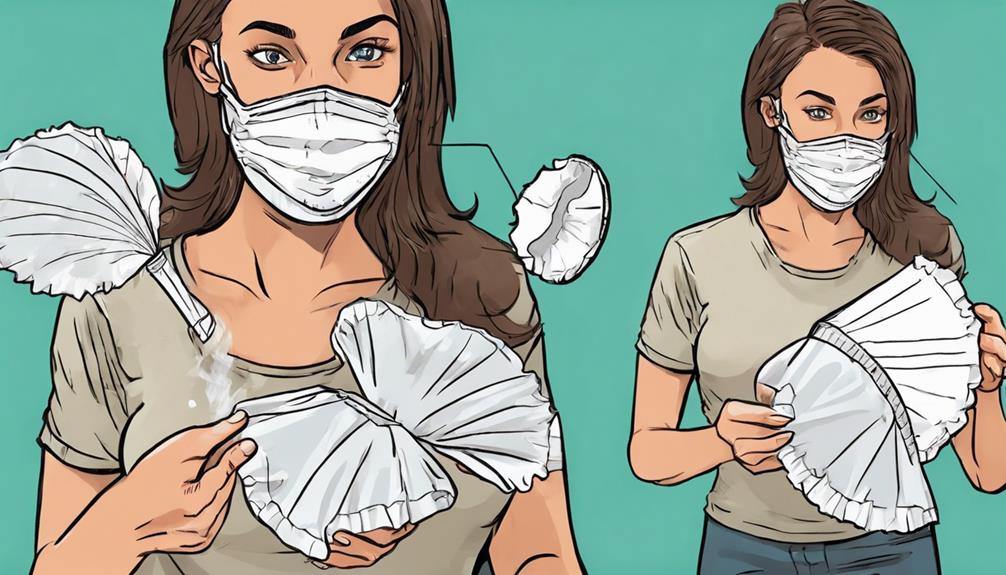
When considering DIY face mask pattern options, it's important to select designs that feature a pocket for inserting a coffee filter to enhance protection.
DIY face mask patterns that include this pocket offer the flexibility to insert a coffee filter, which can act as an additional layer of filtration for increased effectiveness. These patterns allow for easy insertion and removal of the coffee filter, making it convenient to replace the filter when needed.
Opting for DIY face mask patterns with a designated pocket for a coffee filter guarantees that you can easily access and utilize this additional protective measure. With coffee filters being a common household item, this method is both accessible and cost-effective.
Scientific Research on Filter Materials

You should know that scientific research plays a critical role in evaluating the effectiveness of different filter materials in face masks.
Studies have demonstrated that materials like HEPA vacuum cleaner bag filters can offer high levels of particle filtration.
Filter Material Research
An essential aspect of DIY face mask construction is the scientific research on filter materials to determine their effectiveness. Scientific evidence plays a pivotal role in understanding the filtration efficiency, breathability, and overall protection offered by various filter materials.
Researchers rely on studies to gather data on the composition and safety of filter materials, often consulting Material Safety Data Sheets (MSDS) for vital information. Through research, reliable filter materials like HEPA vacuum cleaner bag filters or Halyard 600 Medical Grade Fabric are identified for best protection.
It's important to note that the effectiveness of filter materials can differ, underscoring the importance of scientific evidence and testing when selecting materials for DIY face mask filtration. By staying informed and utilizing research findings, you can enhance the protective capabilities of your homemade face mask effectively.
Scientific Testing Importance
Scientific testing plays an essential role in evaluating the effectiveness of filter materials used in homemade face masks. Research studies provide valuable data on the filtration efficiency and safety of various filter materials, ensuring they meet required standards for protecting against airborne particles. Material Safety Data Sheets offer essential information on the composition and suitability of filter materials for face masks. By conducting scientific testing, users can make informed decisions when selecting filter materials for DIY face masks. To illustrate the importance of scientific testing, consider the following table showcasing different filter materials commonly used in homemade face masks:
| Filter Material | Filtration Efficiency | Safety Information |
|---|---|---|
| Coffee Filters | High | Generally safe to use |
| HEPA Filters | Very High | May contain fiberglass |
| Cotton Fabric | Moderate | Breathable and natural |
| Vacuum Bags | High | May need proper sealing |
Verified Filter Effectiveness
Research findings have conclusively demonstrated the effectiveness of coffee filters as a filter material for homemade face masks. Scientific research has shown that coffee filters can provide a preliminary filtration effectiveness of 40-50% when used in multiple layers. This makes them a valuable addition to DIY face masks for enhanced protection.
The effectiveness of coffee filters as a filter material for face masks has been supported by preliminary tests, indicating their ability to capture particles. Using thin coffee filters in DIY face masks can offer an additional layer of protection against particles, making them a practical choice for individuals looking to improve the filtration efficiency of their masks.
Additionally, coffee filters can be a cost-effective and readily available option for enhancing the filtration efficiency of homemade face masks, ensuring that you can easily access materials to boost the protective qualities of your mask. While coffee filters can improve filtration effectiveness, it's important to balance this with breathability for comfortable mask usage.
Availability of Filter Materials
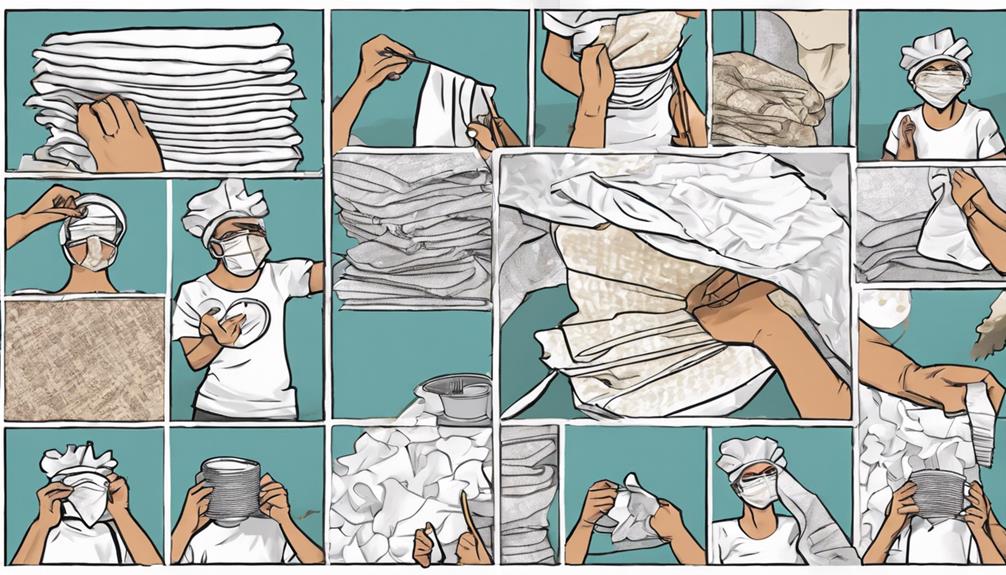
Filter materials like coffee filters and HEPA vacuum cleaner bag filters are easily accessible for mask-making, with availability varying across different retail outlets. Coffee filters can be readily found in grocery stores, making them a convenient choice for adding an extra layer of protection to your DIY face mask.
On the other hand, HEPA vacuum cleaner bag filters may be available online or in select stores, but their availability could be limited compared to coffee filters.
Additionally, materials like blue shop towels, paper towels, and interfacing can be purchased at fabric stores to enhance the filtration capabilities of your mask. While cotton batting may not provide as much protection as other filter materials, it can be sourced from craft stores for those looking for alternatives.
When selecting a filter material, it's important to bear in mind both its availability and breathability to make sure you choose the best option for your needs.
Testing Filter Material Effectiveness

Preliminary tests suggest that combining thin coffee filters in your DIY face mask can enhance its filtration effectiveness by 40-50%.
When testing filter material effectiveness for face masks, it's vital to explore various options:
- Blue Shop Towels: Research is underway to confirm their filtration effectiveness.
- Paper Towels: While commonly used, their filtration effectiveness in face masks lacks scientific backing.
- Interfacing Materials: Non-woven types are potential filter materials, but their filtration effectiveness isn't yet supported by research.
It's necessary to understand the filtration capabilities of different materials before incorporating them into your DIY face mask.
While coffee filters show promise, further research is needed to explore the effectiveness of alternative options such as blue shop towels and interfacing materials.
Stay informed and choose filter materials wisely to maximize your face mask's protective benefits.
Face Mask DIY Tutorial

Incorporate additional protection into your homemade face mask by following Director Colleen Bishop's tutorial on attaching a coffee filter. By integrating a coffee filter into your DIY face mask, you can enhance its filtration effectiveness and create an additional barrier against particles and droplets. Below is a step-by-step guide to help you follow the DIY tutorial and successfully attach a coffee filter to your mask: First, place your homemade mask on a clean, flat surface. Next, fold a coffee filter in half and tuck it into the inside pocket of your mask. Make sure the filter covers your nose and mouth, and adjust as needed for a comfortable fit. Now, not only will your mask provide protection, but it will also aid in brightening your coffeestained teeth.
| Step | Instructions |
|---|---|
| Step 1 | Fold the coffee filter in half to fit the mask shape. |
| Step 2 | Insert the folded filter into the middle of the mask. |
| Step 3 | Secure the filter in place by stitching around the edges. |
| Step 4 | Verify the filter is flat and covers the nose and mouth. |
| Step 5 | Test the mask to confirm proper fit and comfort. |
Materials Needed for DIY Face Mask
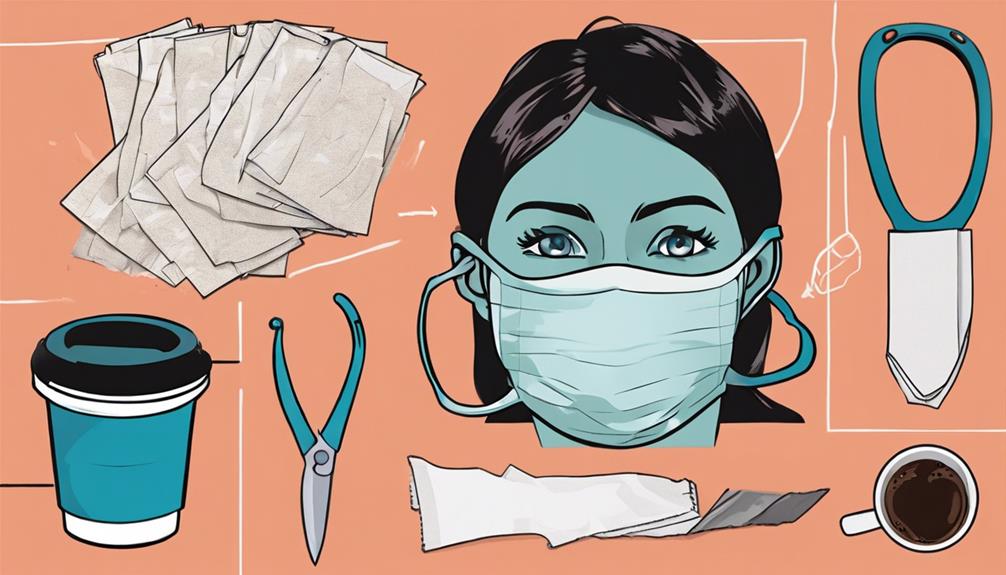
Gather thin coffee filters, tape, rubber bands or elastics, a paper tube or straight edge, and a hole punch for making your DIY face mask.
When preparing your materials, remember:
- Thin Coffee Filters: These are necessary for providing an additional layer of protection in your homemade face mask.
- Tape: Use tape to securely attach the coffee filter within the mask, ensuring proper filtration.
- Rubber Bands or Elastics for Ear Loops: These are essential for creating comfortable and secure ear loops, allowing the mask to stay in place.
Care and Maintenance of Face Masks
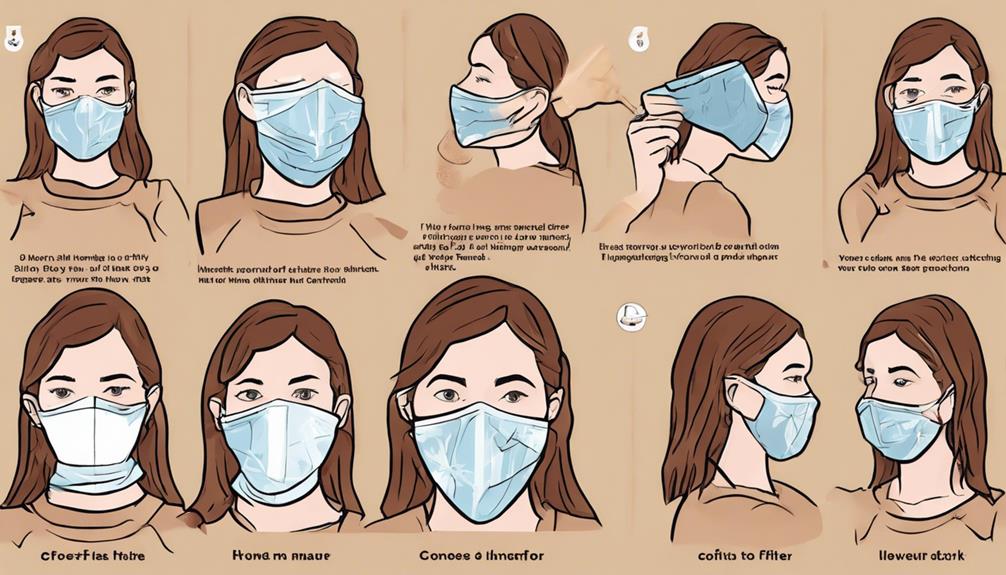
For maintaining the effectiveness of your homemade face mask, it's important to properly clean and replace the filter after each use.
Clean your mask after every use by washing it with warm, soapy water or in a washing machine. Make sure the mask is completely dry before using it again; you can either use a dryer on high heat or hang it up to air dry.
Before washing the mask, remember to remove and dispose of the filter. Once the mask is dry, insert a new filter before wearing it again.
It's essential to replace the filter if it becomes wet, damaged, or less effective to guarantee maximum protection.
Face Mask Effectiveness for COVID-19
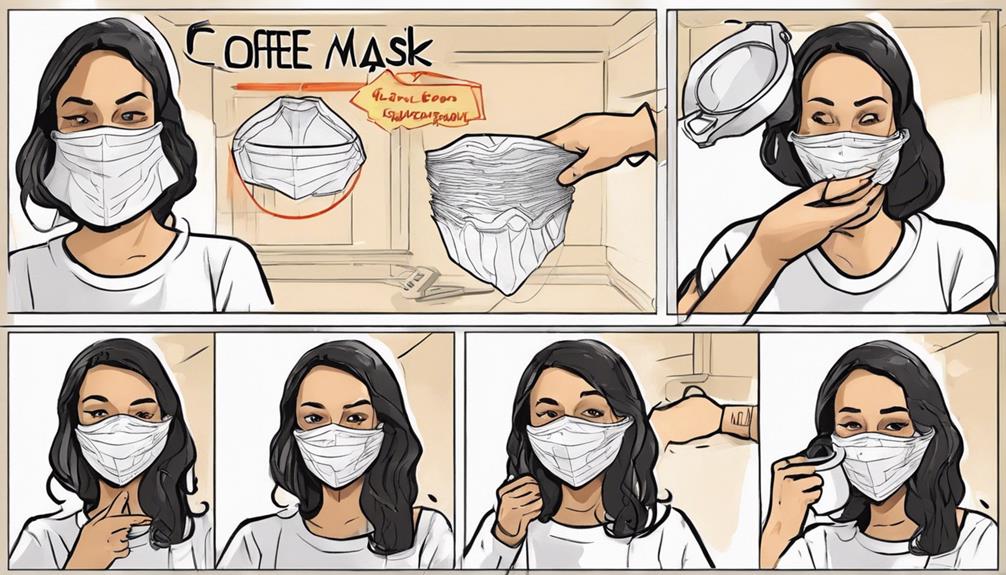
Homemade cloth face masks, when properly constructed and worn, can greatly reduce the transmission of viral aerosols, including COVID-19. These masks serve as an essential tool in combating the spread of the virus, especially when used in conjunction with other preventive measures.
To maximize their effectiveness, remember to:
- Ensure a snug fit: A well-fitted homemade mask can create a barrier that limits the escape of respiratory droplets.
- Use multiple layers: Increasing the number of layers in your cloth face covering enhances its filtration capabilities.
- Wash regularly: Keeping your homemade mask clean is vital for preventing the accumulation of potentially infectious particles.
While homemade masks may not offer the same level of protection as medical-grade respirators, their role in reducing the transmission of COVID-19 can't be underestimated. By embracing the use of a cloth face covering, you contribute to safeguarding both yourself and those around you.
Face Mask Fashion Stories
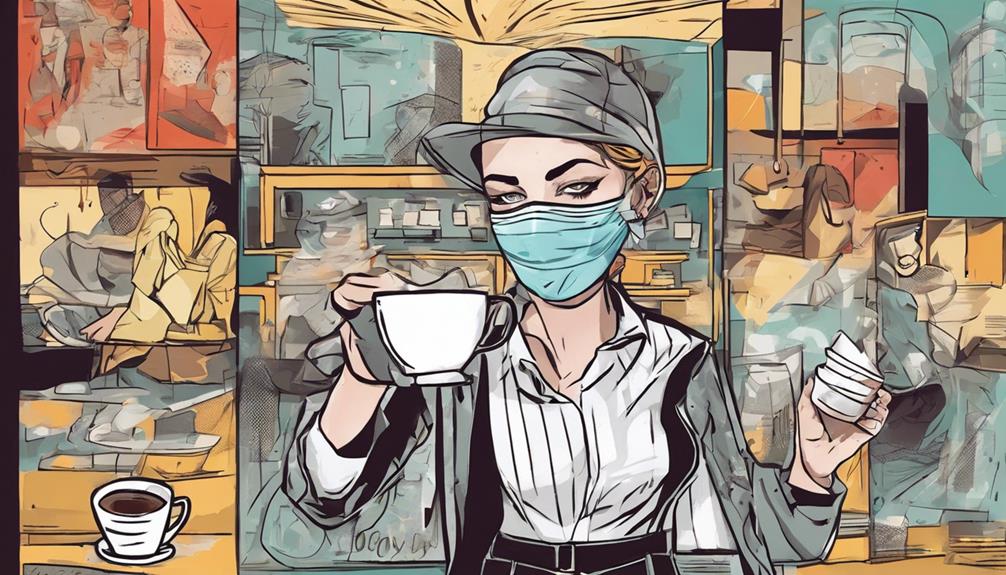
Explore mesmerizing fashion tales surrounding face masks and their innovative designs within the creative realm. From intricately embroidered cloth masks to avant-garde mask collections on the runway, the fusion of fashion and functionality has never been more enthralling.
Immerse yourself in the world of mask couture, where designers push the boundaries of traditional mask-making, transforming a necessity into a statement piece.
Discover how industry professionals and fashion graduates are reshaping the mask landscape, blending craftsmanship with sustainability. Uncover collaborations and fashion programs at institutions like Blanche Macdonald Centre that nurture the next generation of mask designers.
Stay ahead of the curve by following trends in fashion marketing, luxury reconceptualization, and sustainable fashion within the mask industry.
Subscribe to newsletters offering the latest news and updates on mask fashion, where each thread and stitch tells a unique story of creativity and resilience in the face of adversity. Join the movement of embracing masks not just as protective gear but as a canvas for artistic expression.
Frequently Asked Questions
How Do You Make a Face Mask With a Coffee Filter?
Fold three layers of thin coffee filters and secure them with tape. Create crease lines by folding in half twice. Use a paper tube for precise folding. Customize the fit by adjusting nose and chin creases.
How to Make a Filtration Mask?
To make a filtration mask, layer a coffee filter between fabric pieces for added protection. Guarantee a snug fit by experimenting with folding techniques. Regularly replace the filter to maintain effectiveness. Stay safe and keep filtering!
How Do You Put a Filter Pocket on a Face Mask?
You can put a filter pocket on a face mask by creating a small opening for inserting a filter. Confirm the filter fits snugly for better coverage. Secure the pocket opening to keep the filter in place.
How to Prepare a Coffee Mask for the Face?
Prepare a coffee mask for your face by folding a coffee filter in layers, securing it within the fabric folds using tape. Position it over your nose and mouth for best filtration. Experiment with different filters for customized protection.
Conclusion
So there you have it – adding a coffee filter to your DIY face mask can provide extra protection against harmful particles.
In fact, a study found that masks with a coffee filter insert were able to block up to 50% more particles than masks without one.
Stay safe and stylish with your homemade face mask!
